#Mario Bauzá
Explore tagged Tumblr posts
Text
Mario Bauzá: Pioneering Afro-Cuban Jazz and the Legacy of a Musical Innovator
Introduction: Mario Bauzá, born one hundred and thirteen years ago today on April 28, 1911, in Havana, Cuba, was a pivotal figure in the development of Afro-Cuban jazz. His contributions as a musician, composer, and bandleader helped shape the sound of Latin jazz and left an indelible mark on the world of music. Early Life and Influences: Bauzá, raised in Havana, showed prodigious talent on…
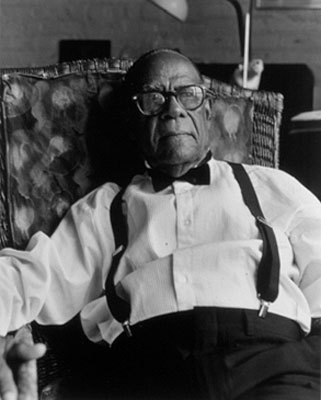
View On WordPress
#Afro-Cuban jazz#Carlos Santana#Dizzy Gillespie#Eddie Palmieri#Frankie Trumbauer#George Gershwin#Jazz Clarinetists#Jazz Composers#Jazz History#Jazz Saxophonists#Jazz Trumpeters#Machito#Machito and His Afro-Cubans orchestra#Mario Bauzá#René Endreira#The Santo Domingo Serenaders#Tito Puente
12 notes
·
View notes
Text
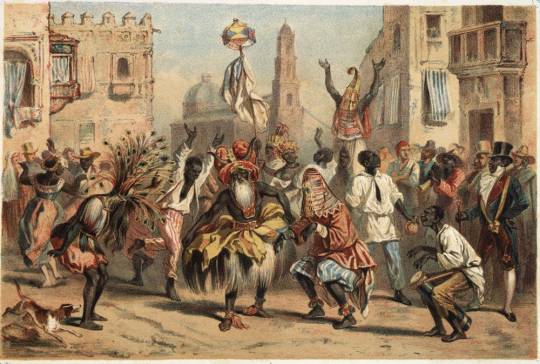
Long before it arose in New York City and became an influential style of music around the world, salsa music has its seeds in African rhythms and traditions that came to the Caribbean through the slave trade. Centuries of enslavement caused many cultural changes in Cuba, including the music that led to salsa.
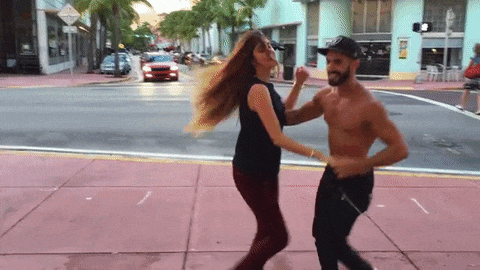
Some people know Bobby Day’s 1958 “Rockin’ Robin” or Michael Jackson’s remake but the origin of the song goes back to the days of slavery.
The majority of the Africans that were enslaved and brought to the Americas were of West African descent where the drum was used as a form of communication. In the Americas, enslaved Africans used the drum in the same way — communicating with the enslaved on distant plantations and ultimately planning uprising.
The enslavers caught wind of this and enacted a ban.
It is absolutely necessary to the safety of this Province, that all due care be taken to restrain Negroes from using or keeping of drums, which may call together or give sign or notice to one another of their wicked designs and purposes. — Slave Code of South Carolina, Article 36
That ban went down in 1740 and soon spread throughout Colonial America.
But the beat is in the heart of the African.
We soon found other ways to imitate the sound of the drum; stomping, playing spoons, washboards, or anything other household item. We also “slapped Juba” or played “hambone” where the body became an instrument where the player slaps their thighs and chest for the drum beat.��(How did young boys in 1980s Park Hill, Denver know “Hambone?”)
Although we kept the beat, we lost the tradition, a cultural marker snatched away from us.
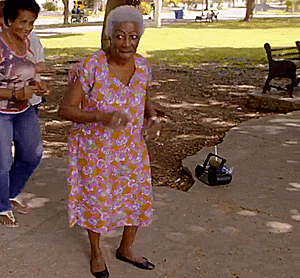
While the American enslaver worked feverishly to destroy any vestige of African culture, the Spanish enslaver of Cuba felt that it was in his best interest to allow the enslaved African to maintain his culture. In support of that, the Spanish allowed the Africans to organize Cabildos (or social groups) based on their nation of origin. Thus you had the Abakua (or Ekpe) from the nations known as Nigeria and Cameroon, the Madinga (or Malinke) from Sierre Leone, etc.
Our focus is primarily on the Lucumi, the Cabildo founded for the Yoruba of Benin and Nigeria. This lineage would be the cornerstone and origin point for what is now called “Salsa.” And what is this “Salsa?”
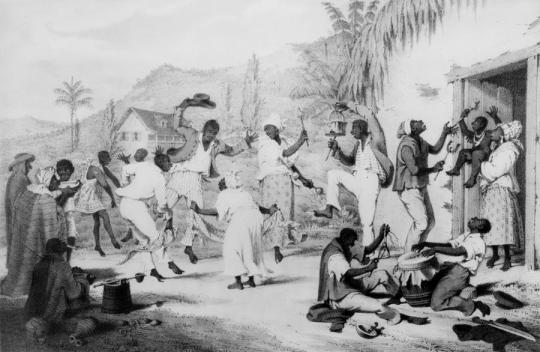
When we spoke of the drum being forbidden among the enslaved Africans in America, we forgot to mention that there was one place that didn’t enact that ban. That place was the port city of New Orleans, Louisiana — some even call New Orleans the Northernmost Caribbean city.
Similar in the way that the Spanish allowed for Cabildos in Cuba, the Louisiana enslavers permitted Sundays off and were okay with the dance and celebration so long as the enslaved African did so outside of the city limits in a place called Place des Negres (eventually known as Congo Square).
After the Civil War, Africans in America were able to get a hold of surplus brass instruments and shortly thereafter began composing music based on the popular music in the Caribbean at the time, the Cuban Habanero. Many say that this is one of the foundations of jazz music itself and the basis of the habanero, the tressilo, can be heard in second lines. Self-proclaimed jazz inventor, Jelly Roll Morton had this to say:
Now take the habanero “La Paloma”, which I transformed in New Orleans style. You leave the left hand just the same. The difference comes in the right hand — in the syncopation, which gives it an entirely different color that really changes the color from red to blue. Now in one of my earliest tunes, “New Orleans Blues”, you can notice the Spanish tinge. In fact, if you can’t manage to put tinges of Spanish in your tunes, you will never be able to get the right seasoning, I call it, for jazz. Jelly Roll Morton
Because of those qualities, a young musical prodigy from Cuba, Mario Bauzá recognized the similarities between jazz and Cuban music straightaway. Bauzá fell in love with jazz having heard it on Cuban radio but it was his trip to Harlem, NYC in 1927 that convinced him that New York was where he wanted to be and jazz was the music that he wanted to play.
Bauzá returned to New York in 1930, immediately found work, eventually landing a gig in the Cab Calloway band. Here he brought on the legend in the making, Dizzy Gillespie, and the two became fast friends. Bauzá attempted to play his “native” music to many in the band but they dismissed it as “country” music. Gillespie, on the other hand, embraced it.
For the next eight years Bauzá played in predominately African jazz bands having seen discrimination from white Cubans. Yet he longed to start a group that incorporated the music from his home and his second love, jazz. He shot this idea to his childhood friend/brother-in-law and in 1939 at the Park Palace Ballroom the Machito Afro-Cubans would debut.
“I am Black, which means my roots are in Africa. Why should I be ashamed of that?” Bauzá said in reference to the name.
Bauzá replaced the drum kit, which at that time had only been around for 20 years, with the hard to find congas, timbales, and toms. “The timbales play the bell pattern, the congas play the supportive drum part, and the bongos improvise, simulating a lead drum”. In the 40s these drums could only be found at Simon Jou’s bakery, La Moderna, locally known in East Harlem simply as Simon’s.
Next, the Afro-Cubans needed a home and they would find that not in Harlem nor the Bronx, but instead in Midtown Manhattan, a club called the Palladium.

Salsa is a set of Afro-Caribbean rhythms fused with jazz and other styles. The truth is that its origins have always been much debated, although as a general rule it is mentioned that it comes from a fusion that came from Africa in the Caribbean when they heard European music and wanted to mix it with their drums
These origins focus especially on mambo, danzó, cha cha chá, guaracha and son montuno, later enriched with instruments such as saxophone, trumpet or trombone.
It was the Cuban exiles and those from Puerto Rico who popularized salsa in New York back in the 1950s. But it wasn't until the last third of this century that salsa dancing began to take off all over the world.
Cuba played a leading role in the origin of salsa. Already in the 1930s, melodies and rhythms from Africa were playing on the Caribbean island. Among them was the danzón, a musical piece acquired by the French who had fled Haiti.
History tells us that it was these first rhythms that were then mixed with rumbas such as guagancó and sonero to begin to create their own Afro-Cuban rhythms, including Afro-Cuban jazz, mambo, guaracha, Cuban son and montuno.
The exquisite melody of these new rhythms soon set in other Latin American countries. Puerto Rico and Colombia were the first to welcome these new sounds from the Cuban country.
However, it was not until their appearance in the United States, and more specifically in the Bronx neighborhood of New York, when these rhythms acquired a greater impact. It was the moment in which new musical instruments were added that today form an indissoluble part of salsa.
The great Cuban musicians who moved to New York along with the wave of these new rhythms created the famous tumbadoras, congas or son montuno, and were responsible for introducing trombones and guaracha.
The Origin of the Salsa Dance Steps
Once salsa was defined as a musical genre in the 1970s, the movements and steps of its dance were collected through a fusion of the African with the European.
These steps and movements of salsa fundamentally reflect the influence of the dances that the Africans brought to the Caribbean and the European dances that have been danced in Cuba since the 1930s.
So much so that the basic steps of salsa are precisely the same steps as the Cuban son, just as it also includes steps that can be seen in rumba, danzón and mambo.
The origin of these variants is in the regions where this style comes from, which are the ones that developed each dance, always under the same umbrella of the term salsa.
It is not surprising, then, that salsa is defined as the result of a series of social conditions and the evolution of a series of rhythms and melodies from Cuba, which were developed and achieved repercussion in the United States.
There are those who assure against this mixture that salsa is neither a rhythm nor a style, but rather a term that serves to represent all the music of Afro-Cuban origin that emerged in the first decades of the twentieth century.
In short, the origin of salsa has always been, and will continue to be, much discussed. American musician Tito Puente was right when he said, "Salsa doesn't exist. What they now call salsa is what I have played for many years, and this is mambo, guaracha, cha cha chá and guagancó".
#salsa#cuba#congo#nigeria#african#afrakan#kemetic dreams#brownskin#africans#afrakans#brown skin#african culture#afrakan spirituality#nigerian#nigerians#ghana#niger#cameroon#senegal#west africa#afro cuban#american#african american#african american history#american history#dance#african dance#congo dance#ekik#yoruba
23 notes
·
View notes
Text
youtube
Mario Bauzá - Son Cubano (Yo Soy El Son Cubano)
2 notes
·
View notes
Text

Mario Bauzá (April 28, 1911 – July 11, 1993) was a jazz, Latin, and Afro-Cuban jazz musician. He was one of the first to introduce Cuban music to the US by bringing Cuban musical styles to the New York City jazz scene. While Cuban bands had had popular jazz tunes in their repertoire for years, his composition “Tangá” was the first piece to blend jazz harmony and arranging technique, with jazz soloists and Afro-Cuban rhythms. It is considered the first true Afro-Cuban jazz or Latin jazz tune.
He studied clarinet becoming recognized as a child prodigy on the instrument leading to being featured with the budding Havana Symphony at the age of 11. He performed on clarinet and bass clarinet with pianist Antonio Maria Romeu’s charanga orchestra. He witnessed a performance of George Gershwin’s “Rhapsody In Blue” and was inspired by saxophonist Frankie Trumbauer’s feature in the piece. Upon his return to Cuba, he vowed he would return to NYC to become a jazz musician doing so in 1930 learning to play the alto saxophone while maintaining his clarinet technique. #africanhistory365 #africanexcellence
2 notes
·
View notes
Text
Incidencia - 31
– ORGANIZACIONES DEL EXILIO CUBANO CONVOCAN A EVENTO HOMENAJE AL PATRIOTA MIGUEL DÍAZ BAUZÁ, MÁS DE 30 AÑOS EN PRISIÓN. -CATEDRAL DE NOTRE DAME DE PARÍS REABRIRÁ SUS PUERTAS AL PÚBLICO, CERRADAS A CAUSA DEL INCENCIO EN 2019. -NUEVO JEFE DE MISIÓN DIPLOMÁTICA DE ESTADOS UNIDOS EN CUBA VALORA LAS LIBERTADES RELIGIOSAS, COMENTARIO DEL PASTOR MARIO FÉLIX LLEONART BARROSO. Para escuchar en Sound…
#AICNOR#AIEC#Alianza de Iglesias Cubanas No Registradas#Alianza de Iglesias Evangélicas Cubanas#Asociación Convención Bautista de Cuba Occidental#CIC#Consejo de Iglesias de Cuba#Convención Bautista de Cuba Oriental#Iglesia Evangélica Pentecostal de Cuba Asamblea de Dios#Iglesia Metodista en Cuba#Jefe de Misión de los Estados Unidos en Cuba#José Daniel Ferrer#Josué Rodríguez Legrá#Liga Evangélica de Cuba#Mike Hammer#Moisés de Prada Esquivel#Oficina de Atención a los Asuntos Religiosos del Comité Central de Partido Comunista de Cuba#Petr Kaván#Ricardo Pereira Díaz
0 notes
Photo

28 de abril, 1911
Nace uno de los pioneros afro latinos del Jazz: El cubano Mario Bauzá.
Además fue saxofonista, clarinetista, trompetist, arreglista y director de la orquesta “Machito”. Puedes escuchar una de sus obras haciendo clic en la imagen.
1 note
·
View note
Audio
Algunas canciones podrían ser: Toma cinco, peligroso amor, mambo diablo, helado de chocolate, vámonos pa’l monte entre otras canciones de artistas muy importantes para el género del jazz. El jazz latino con el tiempo se enriqueció con influencias musicales procedentes de Argentina, Puerto Rico, República Dominicana, Venezuela, Colombia y el resto de Latinoamérica. Algunos de los artistas del jazz latino son: Paquito d’ Rivera, Tito Puente, Mongo santamaría, Mario Bauzá, Bebo valdés entre mucho más. Uno de los subgéneros del jazz que más crecimiento tuvo es el llamado Latin Jazz, donde las raíces de la música del caribe se fusionaron con los sonidos del jazz en una época y una ciudad que no podía ser de otra manera.
1 note
·
View note
Video
Mario Bauzá (Trompeta) Mario Bauzá es muy reconocido por llevar al jazz música de su Cuba natal. Trabajó con Noble Sissle y Chick Webb en Nueva York en los años treinta antes de asociarse con…
#cab calloway#congas#cubano#cubop#JAZZ#jazz latino#latin#latin trumpet#machito#mario bauza#música#música latina#música ritmo#music#percusión#ritmica#ritmo#trompeta latina
2 notes
·
View notes
Photo

Machito: Kenya One cannot talk about Latin jazz without mentioning one of its fathers, Francisco Raúl Gutiérrez Grillo, better known as Machito. He moved to New York from Cuba, eventually forming his band the Afro-Cubans in 1940 that, with the help of musical director Mario Bauzá, were among the first to combine traditional jazz arrangements with Afro-Cuban rhythms, frequently hiring American jazz composers to arrange Cuban songs. Kenya (1958) features mostly original songs written and arranged by A.K. Salim. At first glance you might think the album is all big band glitz with a loud brass section that jumps on the exotica fad of the ’50s, but if you dig deeper you can also hear what sets Machito apart from the imitators. The tight musicianship, the complex jazz arrangements that quickly turn from high-impact to subtle soulful phrases; there is no way Kenya can be dismissed as a fad album. The album also features some stellar jazz solos from the likes of trumpeter “Doc” Cheatham (“Holiday”), alto-sax great Cannonball Adderley (“Oyeme” and “Congo Mulence”) and others. https://www.instagram.com/p/CK2aC3WFE_n/?igshid=ddi9r3txwic0
0 notes
Text









Un Día Como Hoy de hace 99 años. 28 de octubre de 1921 nació en La Habana, Cuba el compositor y arreglista Arturo O'Farrill más conocido como Chico O'Farrill, uno de los músicos más lúcidos de la isla, hijo de padres irlandeses fue, luego de Mario Bauzá, uno de los más grandes innovadores del concepto orquestal de la música afrocubana, inicio como trompetista en la Habana y después en New York, llegó a trabajar como arreglador de Count Basie, nada menos, después de la separación de Bauza y Machito fue arreglista de la Orquesta de Machito, asi como el arreglo del tema "Tanga" original de Mario Bauza para la United Nations Orchestra de Dizzy Gillespie, así como el mejor disco del saxofonista tenor argentino Gato Barbieri "Chapter Three: Viva Emiliano Zapata".
Durante los 70s hizo música para cine en México. Fue víctima de plagio en algunas de sus obras.
En el año 2000 fue incluido en el documental Calle 54 de Fernado Trueba. En 2001 el filosofo belga Luc Delanoy en su obra "Caliente: una historia del jazz latino" lo describe simplemente como el arquitecto del Latin jazz.
1 note
·
View note
Photo

Mario Bauzá (April 28, 1911 – July 11, 1993) was jazz, Latin, and Afro-Cuban jazz musician. He was one of the first to introduce Cuban music to the US by bringing Cuban musical styles to the New York City jazz scene. While Cuban bands had had popular jazz tunes in their repertoire for years, his composition "Tangá" was the first piece to blend jazz harmony and arranging technique, with jazz soloists and Afro-Cuban rhythms. It is considered the first true Afro-Cuban jazz or Latin jazz tune. He studied clarinet becoming recognized as a child prodigy on the instrument leading to being featured with the budding Havana Symphony at the age of 11. He then performed on clarinet and bass clarinet with pianist Antonio Maria Romeu's charanga orchestra. He witnessed a performance of George Gershwin's "Rhapsody In Blue" and was inspired by saxophonist Frankie Trumbauer's feature in the piece. Upon his return to Cuba, he vowed he would return to NYC to become a jazz musician doing so in 1930 learning to play the alto saxophone while maintaining his clarinet technique. #africanhistory365 #africanexcellence https://www.instagram.com/p/Cc4_q41O6tz_XjTcFNVVOLWUxLCzBH24HAsVmA0/?igshid=NGJjMDIxMWI=
0 notes
Photo

Carroza de la Seeco en desfile de la hispanidad en New York en 1958 con Machito, Graciela, Bauzá y los AfroCubanos. Foto propiedad Mario Grillo "Machito Jr" (archivos familiares) (en Mi Cueva Privada) https://www.instagram.com/p/CF129MOM1cZ/?igshid=qd51mvg9mkno
0 notes
Text
Origen del jazz
El jazz Latino es una rama del jazz que se nutre de la fusión de ritmos y formas originarias de la música latina, sobre todo la cubana y la brasileña. El jazz latino no es una sub categoría del jazz como el bebop, el swing o el “cool.” El jazz latino tiene su propia historia, su estilo de presentación y sus conceptos musicales.
el jazz latino surgió desde sus raíces en Europa, Africa y las Américas y llegó a ser un árbol musical con sus propias ramas estilísticas. El pionero de jazz Jelly Roll Morton comprendió el impacto del sabor latino en un momento en que jazz aún era una palabra nueva para la mayoría de los americanos . El se refería específicamente a un ritmo que podía oírse en aquel jazz precoz de New Orleans. Ese sabor latino del cual Morton hablaba estaba relacionado directamente con la habanera, un estilo de música que, por esos días, estaba emergiendo en los salones de baile de La Habana, Cuba. Y así como los músicos de jazz estaban sintiendo ese sabor latino.Los años 40 fueron claves en el desarrollo del jazz latino, específicamente el jazz afrocubano. Varios estilos de baile y escuelas de jazz se cruzaron en las cuidadosas manos de los trompetistas Dizzy Gillespie y Mario Bauzá. Ambos músicos estaban muy ocupados trabajando en los clubes de la calle 52 en New York y en las más famosas salas de baile de la ciudad
0 notes
Text
East Harlem “El Barrio”
“... Little Italy, Spanish Harlem, El Barrio. East Harlem runs from 96th St up to 143rd St from the east side of Fifth Avenue to the Harlem River. ... It was Manhattan’s first Little Italy and the political base for legendary New York Mayor Fiorello La Guardia. The Italian community largely moved on in the 1980s. The Feast of Our Lady of Mount Carmel and the Dancing of the Giglio are remnants of Italian East Harlem. Part of East Harlem became ‘Spanish Harlem’ after World War 1 (1914-1918). ... Like most of New York City, El Barrio was a tough neighborhood in the 1970s. But it also birthed community movements as young people turned from running gangs to running social programs. ...”
East Harlem “El Barrio”
2011 November: Charlie Palmieri, 2014 October: Fania at Fifty, 2017 December: Nu Yorica: Culture Clash In New York City - Experiments in Latin Music 1970-77, 2018 December: Latin Underground Revolution: Swinging Boogaloo, Guaguanco, Salsa & Latin Funk from New York City 1967-1978, 2017 June: Eddie Palmieri - Unfinished Masterpiece (1976), 2018 July: The Soul Of Spanish Harlem / El Barrio: Sounds from the Spanish Harlem Streets, 2011 June: Mario Bauzá, 2017 June: Rhythm & Power: Salsa in New York, 2012 February: Rubén Blades, 2017 December: Carlos Vera: Barcelona's Boogaloo: Mixes and Mashups, 2019 April: An NYC Mambo, Boogaloo and Salsa Family Tree, 2021 February: Fania Records, 2022 January: East Harlem/Spanish Harlem/El Barrio
Mural in El Barrio East Harlem, NYC at 1645 Lexington at 104th St
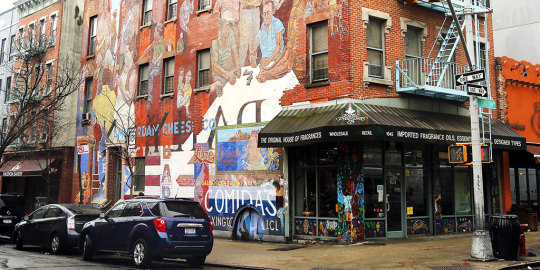
0 notes
Photo

#FútbolFemenino #DeporteFemenino Este fin de semana, se jugó el clásico entre #Peñarol y #Nacional en la divisional A, y tambien se disputaron los partidos en la Segunda División y las categorías sub-19 y sub-16. Estos fueron los resultados y son: Torneo de Ascenso – Segunda División FECHA 5 Domingo 10 de noviembre Defensor Sporting 2-2 Danubio Estadio: Complejo Arsuaga Hora: 12.00 Atenas 3-0 Juventud Estadio: Atenas (Cancha Nº 2) Hora: 12.00 Cerro 1-1 Náutico Estadio: Complejo Héctor da Cunha Hora: 15.30 Canadian 0-1 Racing Estadio: Julio César Abbadie (Pan de Azúcar) Hora: 16.00 Torneo Permanencia – Segunda División FECHA 5 Domingo 10 de noviembre UdelaR 12-1 Boston River Estadio: Complejo Bauzá Hora: 10.00 San José 2-2 Rampla Juniors Estadio: Casto Martínez Laguarda Hora: 12.00 Wanderers 12-0 Keguay Estadio: Complejo Devoto Hora: 15.30 Miramar Misiones 0-2 Albion Estadio: Parque Méndez Piana Hora: 16.00 Copa de Oro – Sub-19 FECHA 4 Sábado 9 de noviembre Defensor Sporting 2-1 Peñarol Estadio: Complejo Arsuaga Hora: 10.00 Náutico 1-3 River Plate Estadio: Complejo de Náutico Hora: 14.00 Nacional 3-1 Colón Estadio: Complejo Los Céspedes (Cancha sintética) Hora: 16.00 Domingo 10 de noviembre Atenas – Liverpool Estadio: Atenas (Cancha Nº 2) Hora: 14.30 Copa de Plata – Sub-19 FECHA 4 Domingo 10 de noviembre Central Español – Wanderers Estadio: Complejo de Central Español Hora: 11.00 Progreso – Boston River Estadio: Parque Ancap Hora: 12.00 Plaza Colonia Línea D – Juventud Estadio: Complejo Milton Gonnet Hora: 13.00 Miércoles 13 de noviembre Danubio – Albion Estadio: Complejo Ing. del Campo Hora: 19.00 Copa de Oro – Sub-16 FECHA 5 Sábado 9 de noviembre Fénix Canelones 0-2 Liverpool Estadio: Eduardo Martínez Monegal Hora: 14.00 Rentistas San Jacinto 1-0 Nacional Estadio: Mario Vecino Hora: 16.00 Racing 5-1 Wanderers Estadio: Complejo de Racing Hora: 16.30 #Collage #ProgramaCollage #Noticia #revistacollage #Historia #deporte #Fútbol #FútbolFemenino #FIFA #CONMEBOL #AUFTV #AUF (en Montevideo, Uruguay) https://www.instagram.com/p/B4ysI5CgJBM/?igshid=3tnhjq57edh4
#fútbolfemenino#deportefemenino#peñarol#nacional#collage#programacollage#noticia#revistacollage#historia#deporte#fútbol#fifa#conmebol#auftv#auf
0 notes
Audio
Меренге Mартышка (Homework for Mario Bauzá) by Camarada Martyshka A humble tribute to all the great masters (such as Mario Bauzá) who set the roots of popular music of XX century and beyond. For more details about this track, please check my blog: https://ift.tt/2LMEL2D
0 notes